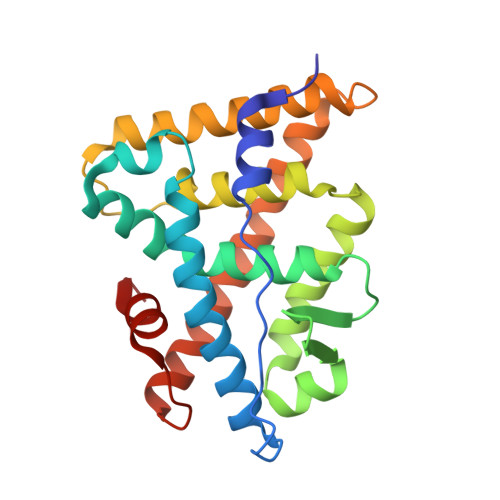Evaluation of the Influence of Halogenation on the Binding of Bisphenol A to the Estrogen-Related Receptor gamma.
Suyama, K., Kaneko, S., Kesamaru, H., Liu, X., Matsushima, A., Kakuta, Y., Okubo, T., Kasatani, K., Nose, T.(2020) Chem Res Toxicol 33: 889-902
- PubMed: 32105061
- DOI: https://doi.org/10.1021/acs.chemrestox.9b00379
- Primary Citation of Related Structures:
6K3N - PubMed Abstract:
Halogenation of organic compounds is one the most important transformations in chemical synthesis and is used for the production of various industrial products. A variety of halogenated bisphenol analogs have recently been developed and are used as alternatives to bisphenol A (BPA), which is a raw material of polycarbonate that has adverse effects in animals. However, limited information is available on the potential toxicity of the halogenated BPA analogs. In the present study, to assess the latent toxicity of halogenated BPA analogs, we evaluated the binding and transcriptional activities of halogenated BPA analogs to the estrogen-related receptor γ (ERRγ), a nuclear receptor that contributes to the growth of nerves and sexual glands. Fluorinated BPA analogs demonstrated strong ERRγ binding potency, and inverse antagonistic activity, similar to BPA. X-ray crystallography and fragment molecular orbital (FMO) calculation revealed that a fluorine-substituted BPA analog could interact with several amino acid residues of ERRγ-LBD, strengthening the binding affinity of the analogs. The ERRγ binding affinity and transcriptional activity of the halogenated BPAs decreased with the increase in the size and number of halogen atom(s). The IC 50 values, determined by the competitive binding assay, correlated well with the binding energy obtained from the docking calculation, suggesting that the docking calculation could correctly estimate the ERRγ binding potency of the BPA analogs. These results confirmed that ERRγ has a ligand binding pocket that fits very well to BPA. Furthermore, this study showed that the binding affinity of the BPA analogs can be predicted by the docking calculation, indicating the importance of the calculation method in the risk assessment of halogenated compounds.
- Faculty of Arts and Science, Kyushu University, Fukuoka 819-0395, Japan.
Organizational Affiliation:

















